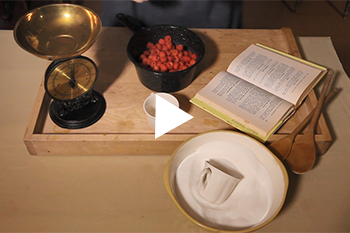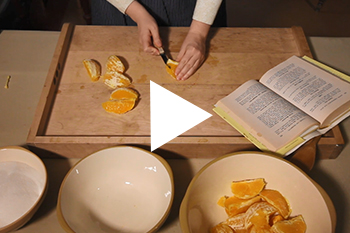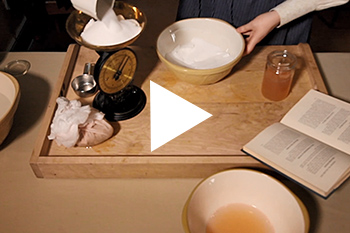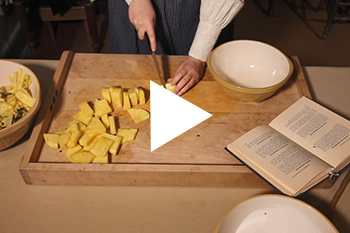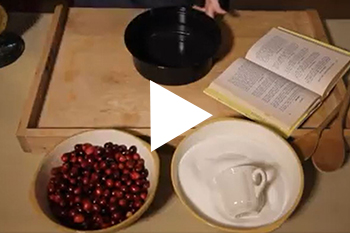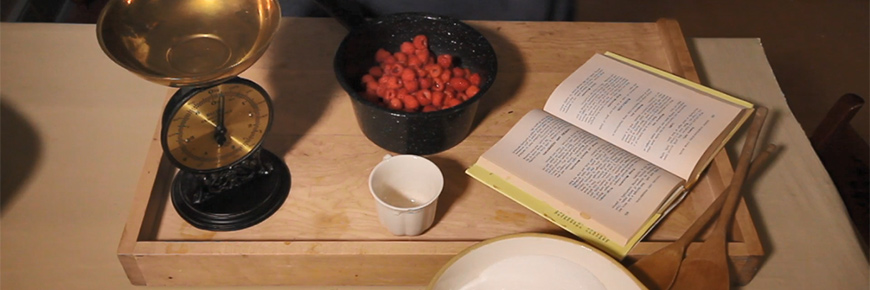
Historic Cooking
Woodside National Historic Site
Woodside’s historic kitchen cam soothes the soul
For many in the Kitchener-Waterloo area, a trip to Woodside in the fall or winter is a treasured family tradition. There is nothing so cozy as walking along the path to the historic house, a slight chill in the air, leaves crunching underfoot, the thin line of wood smoke beckoning all to enter the warmth of the stunning Victorian house and boyhood home of Prime Minister William Lyon Mackenzie King.
Now you can bring the warmth and comfort of the woodstove right to you! Checkout these historic recipes and visit our Facebook page to watch the soothing sites and sounds of costumed interpreters making the recipes as well!
Seasonal recipes
Apple Catsup - from The Berlin Cook Book, circa 1906
Peel and quarter 1 dozen sound tart apples, stew until soft in as little water as possible, then press through a sieve. To 1 quart of the sifted apple, add 1 teacup sugar, 1 teaspoon pepper, 1 of cloves, 1 of mustard, 2 of cinnamon, and 2 medium sized onions, chopped very fine. Stir all together, adding 1 tablespoon of sat and 1-pint vinegar. Boil 1 hour and seal, while hot, in pint preserve jars.
If you want to make this recipe at home, we have some tips:
- If you do not have a sieve, a fine mesh strainer makes a fine substitute. You should be able to push the apple pulp and juice through, but separate the seeds.
- Mustard refers to the dried powder, not to the wet yellow mustard found in new, modern kitchens.
- Boil the mixture directly in a pot to transfer to jars or boil in the glass jars that are set on a riser in a pot.
German Apple Cake - from The Berlin Cook Book, circa 1906
This is a baked like pie. 8 sour apples peeled and grated. Mix with 1 cup sugar, ½ cups of well washed currants, add 2 teaspoons of cornstarch, yolk of old egg, stir this together, flavour to suit with lemon (I prefer no flavour). Line pie dish with a good, rich crust, fill in the above mixture when done, frost it with the following: beaten whites of two eggs, 2 tablespoons of sugar, return at once to oven and bake a light brown.
If you want to make this recipe at home, we have some tips:
- This recipe does not provide a temperature at which to bake this pudding. We recommend a moderate oven – approx. 350 degrees. You should monitor your cake and adjust the baking time or temperature as needed.
- This recipe requires that cooks bake the pie crust before adding in the filling and the frosting. You can use a store bought pie crust.
Fruit Kisses - from The Berlin Cook Book, circa 1906
The whites of 4 eggs, beat to a stiff froth, 2 cups of white sugar, ½ pound of dates, ½ pound walnuts cut fine, a little vanilla. Bake in a moderate oven, put on bottom of pan and grease it.
If you want to make this recipe at home, we have some tips:
- This recipe does not provide a temperature at which to bake these cookies. We recommend a slow oven – approx. 225 degrees for about an hour. The kisses should be dry and crisp.
- This recipe is similar to a modern meringue cookie. To beat the egg whites, we recommend using a modern, electric beater. Stop when you get stiff peaks of egg white – you should be able to turn the beater over and the whites should stick.
- You spoon the mixture on to a greased baking tray. This should not spread much while baking, so you can pack them closely.
Candied Pop-corn - from The Berlin Cook Book, circa 1906
Put into an iron kettle 1 tablespoon of water and 1 teacup of white sugar, boil until ready to candy then throw in 3 quarts of corn nicely popped, stir briskly until the candy is evenly distributed over the corn. Set the kettle from the fire and stir until it is cooled a little and you have each grain separate and crystalized with sugar. Care should be taken not to have too hot a fire less you scorch the corn when crystalizing. Nuts of any kind prepared this way are delicious.
If you want to make this recipe at home, we have some tips:
- Modern cooks can use a medium heat on their stovetop for this recipe, but be mindful to not burn the sugar.
- You can use either corn popped on the stove or in a microwave for this recipe.
Cottage pudding with lemon sauce - from The Berlin Cook Book, circa 1906
Cottage Pudding
1 cup sugar, 1 cup milk, ½ cup of melted butter, 1 egg, 2 teaspoons baking powder, 1 pint sifted flour, bake ¾ an hour. Serve with sauce.
Lemon Sauce
1 lemon, ¾ cup sugar, 1 cup boiling water, 1 ½ tablespoon cornstarch. Pare the lemon, being careful not to take off any of the white part of the rind. Pour the boiling water over the pairings, cover closely and steep 5 minutes. Mix cornstarch, sugar in a saucepan, stir in the steeped water and stir constantly until it boils. Remove from fire at once, add lemon juice. Serve hot.
If you want to make this cranberry recipe at home, we have some tips:
- This recipe does not provide a temperature at which to bake this pudding. We recommend a moderate oven – approx. 350 degrees. You should monitor your pudding and adjust the baking time or temperature as needed.
- If you do not have a flour sifter, you can simply add your flour to a bowl and sift it using a whisk to break up chunks.
Historic jams and preserves
Raspberry Jam - from The 1896 Boston Cooking School Cook Book (1896)
Pick over raspberries. Mash a few in the bottom of a preserving kettle, using a wooden potato masher, and so continue until the fruit is used. Heat slowly to boiling point, and add gradually an equal quantity of heated sugar. Cook slowly forty-five minutes. Put in a stone jar or tumblers.
If you want to make this raspberry jam recipe at home, we have some tips:
- This recipe used roughly 3.5 cups of fruit and 3.5 cups of sugar.
- Boiling time may vary, depending on your stove top and how thick you want your jam. If you want a darker, thicker jam, leave on the heat for longer.
- This recipe can easily be used for other fruits; just remember to use an equal amount of sugar!
Marmalade - from The 1896 Boston Cooking School Cook Book (1896)
Select sour, smooth-skinned oranges. Weight oranges, and allow three-fourth their weight in cut sugar. Remove peel from oranges in quarters. Cook peel until soft in enough boiling water to cover; drain, remove white part from peel by scraping it with a spoon. Cut thin yellow rind in strips, using a pair of scissors. This is more quickly accomplished by cutting through two or three pieces at a time. Divide oranges in sections, remove seeds and tough part of skin. Put into a preserving kettle and heat to boiling point, add sugar gradually, and cook slowly one hour; add rind, and cook one house longer. Turn into glasses.
If you want to make this marmalade recipe at home, we have some tips:
- We used five large oranges and approximately 5 cups of sugar.
- Test to see if an orange peel has boiled long enough by gently scraping it with a spoon. If the white comes off cleanly, it is done. If not, continue to boil, being sure to not over boil.
Apple Jelly - from Mrs. Porter’s Cook Book (1891)
Pare, core and slice your apples; place them in a pan, and pour in water enough to cover them; stew them gently until they are soft, then turn them into a jelly-bag or cheese cloth; let all of the syrup run through without pressing it; then to each pint of this juice put one pound of loaf sugar and boil it to a jelly.
If you want to make this apple jelly recipe at home, we have some tips:
- We used approximately 4.5 lbs of apples (or 9 cups) and 3 cups of sugar.
- One pint is roughly equivalent to 1.5 cups of liquid.
- You can strain your apples through a double layer of cheese cloth over a bowl, in lieu of a jelly bag.
- When the mixture has the consistency of warm honey (thick but runny), it can be jarred.
Pineapple Jam - from Mrs. Porter’s Cook Book (1891)
Choose your pineapple as ripe as you can get them. Pare and cut them into thin slices, weight them, and allow one pound of the best pound-refined loaf sugar to each pound of fruit. Take a deep china bowl or dish, and in it put a layer of fruit and sugar alternately, observing to put a coating of sugar on the top, and let it stand all night.
In the morning, take out the fruit and put the syrup into a preserving-kettle. Boil and skim it until ir is perfectly clear; whilst it is boiling hot pour it over the fruit, and let it stand uncovered until it becomes entirely cold. If it is covered, the steam falls into the syrup and thins it. Put your fruit in glass jars or tumblers, and cover it close by pasting paper over the top.
If you want to make this pineapple recipe at home, we have some tips:
- We used approximately 3 lbs of pineapple (or 6 cups) and 6 cups of sugar.
- The sugar will boil clear in a few minutes, so be sure to keep an eye on it.
Boiling sugar is very hot and can easily burn skin! Take care if you are making this recipe with young cooks.
Cranberry Sauce - from The 1896 Boston Cooking School Cook Book (1896)
Pick over and wash three cups cranberries. Put in a stewpan, add one and one-fourth cups sugar and one cup boiling water. Cover, and boil ten minutes. Care must be taken that they don not boil over. Skin and cool.
If you want to make this cranberry recipe at home, we have some tips:
- If you are making this recipe with young cooks, you can use 1 cup cold water instead of hot before putting on the stove to boil.
- Take care to not let the cranberries boil over. If they do, simply add more water and sugar and continue boiling.
- Recipe can be made right before serving, or in advance and stored in a sealed container in a cool place until used.
Fun Facts about cooking in the 1890s!
Did you know that eggs were not weighed, sorted or graded in the 1890s like they are today. For best results in historic recipes, use medium sized eggs.
Many standard measuring instruments that we have come to know and love were not around at this time. A scale is must in historic cooking as most ingredients are listed by weight. And don’t be surprised to see an ingredient listed by its cost at the time period. Talk about guess work!
Interested in historic cooking and baking? Visit the Heritage Gourmet section on the Parks Canada website.
Note that these historic recipes were not created with the standards in food safety that we have today. If you try these at home, make sure you store them in the fridge and are informed about safe food practices for homemade jams and preserves. Visit the Government of Canada’s food safety page for more details.
- Date modified :
